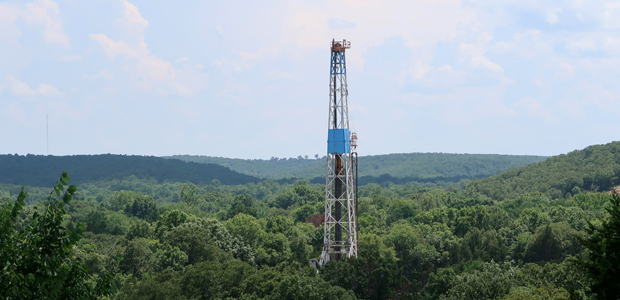
Activity Indicators
Surveys Find Increasing Activity, Investment Optimism
Activity moved higher in the first quarter in the Federal Reserve Bank’s tenth district than year-ago levels for the first time since March 2019, according to the Federal Reserve Bank of Kansas City. The tenth district includes Kansas, Colorado, Nebraska, Oklahoma, Wyoming, and the northern half of New Mexico.
The first-quarter energy survey was released in early April. It shows that energy activity continued to increase moderately in the district, and that respondents expect to further ramp activity levels in coming quarters.
“District drilling and business activity continued to be quite solid in the first quarter, and expectations indicated further growth in the next six months,” says Chad Wilkerson, Oklahoma City Branch executive and economist at the Federal Reserve Bank of Kansas City. “In addition, many firms reported growth in employment for the first time since early 2019, and price expectations for crude oil were the highest they have been in over two years.”
Participants were asked what oil and gas prices were needed for drilling to remain profitable on average across the fields in which they are active. According to Wilkerson, the companies participating in the survey reported that West Texas Intermediate oil prices needed to average $53 a barrel for drilling to be profitable, with a range between $35 and $80/bbl. The average natural gas price needed was $2.94/MMBtu, with responses ranging from $0.75 to $5.00/MMBtu. As of mid-April, WTI was trading at $63 and natural gas was at $2.72 on NYMEX for May delivery.
The companies participating in the survey were contacted in mid to late March. The drilling and business activity index eased only slightly from 40 to 34. Total revenues, profits, employment, employee hours, access to credit, and wages and benefits indexes increased from the previous month.
Positive Territory
Wilkerson says year-over-year indexes moved into positive territory for the first time since early 2019. The year-over-year drilling and business activity index moved from -60 to 10. Indexes for revenues, capital spending, and profits were higher than year-ago levels. On the other hand, he notes, the indexes for employment and access to credit continued to decline.
Expectations indexes increased in the first quarter. The future drilling and business activity index was 40, up from 26 in the fourth quarter of 2020 and 0 in third quarter, indicating more firms expect energy activity to expand.
“The capital expenditures and employment indexes rose substantially, and expectations for revenues, profits, and access to credit also expanded,” the survey results read. “Price expectations for oil, natural gas, and natural gas liquids expanded at a slower pace, but still remained at high levels.”
The firms surveyed were asked what they expected oil and natural gas prices to be in six months, one year, two years, and five years. Overall, expected oil and natural gas prices were higher than previous price expectations in 2020. The average expected WTI prices were $62, $65, $67, and $70/bbl, respectively. The average expected Henry Hub prices were $2.72, $2.94, $3.14, and $3.50/MMBtu, respectively.
Firms were also asked about the possibility of a crude oil supply gap. The results were split, with 42% indicating there would be a supply gap beyond 2021 and 37% reporting no gap would exist after this year. The other 21% was unsure about crude oil supply gap.
In addition, respondents said financing has become more available, with 61% of firms indicating greater financing availability versus 39% reporting less availability. This is in contrast to previous surveys that asked this question, with 22% in 2015 and 42% in 2017 saying more financing was available and 78% and 58% of firms, respectively, reporting less financing availability.
Investment Survey
Oil and gas projects are still attractive to a firm majority of investors, 2021 will have a relatively high price floor and independents appear likely to pave the way on exploration frontiers. Those are a few of the common predictions found in the survey findings from a membership network for senior energy executives, finance and investment professionals.
Energy Council’s “2021 Future Outlook Survey Report: What Does the Future Hold” analysis dug into these and other subjects based on data it obtained in January. The firm says it brokers relationships and provides connectivity for members through tailored events in every major energy city in the world.
According to the Energy Council, segments of survey participants varied, with
- 36.9% identifying as oil and gas companies;
- 22.2% describing themselves as consultancies or law firms;
- 11.6% as nonfinancial service providers;
- 7.5% serving as financial service providers;
- 3.9% identifying as power or utility companies,
- 3.9% describing themselves as a government or national oil company,
- 4.5% as investors,
- 1.4% listing themselves as traders and
- 7.9% claiming an unlisted category.
By region, the proportion of participants that hailed from: • North America was 25.1%;• Europe was 22.1%;
- Asia was 14.1%;
- Africa was 14.0%;
- South America was 11.3%;
- The Middle East was 9.7%; and
- The Caribbean was 3.6%.
Positive Pricing
The report notes that responses in the survey period interval could not account for a number of bullish price factors, such as positive news about the coronavirus vaccine, moves by OPEC+ to restrain output and a slip in U.S. shale output. Even without those factors, it notes:
- 53.5% forecast that West Texas Intermediate crude prices would exceed $50 in 2021,
- 34.0% said it would range between $40 and $50;
- 7.5% of participants said WTI oil prices would be $30-$40;
- 4.1% said $20-$30; and
- less than 1.0% foresaw prices below $20.
On the matter of finance and investment, the report says plenty of respondents remain ready to put their money into the industry.
“The good news is there is still an appetite to invest in, and finance, oil and gas projects,” it states. “According to over 60% of our participants there is capital available for those who want it, reserve based lending is not dead and there is a future for private equity.”
More than 41.5% of respondents said they were very likely to invest in oil and gas projects during the next half-decade, while 43.1 said they might, depending on the project and/or returns. Only 15.4% of respondents ruled out oil and gas investing.
Similarly, less than 10% (8.9%) said they thought RBL was dead, while 46.7 said it was not and 44.4% said they were not sure. On the matter of whether there was a future for private equity in the sector, 82.1% said yes, while only 4.1% said no.
Energy Council does say it appears likely that investors will continue to be choosy, indicating that “the capital availability is there for ‘top-notch’ assets only–there is still a healthy pool of investors who continue to see value and significant future upside potential in the upstream exploration and production sector, but those who will be able to raise it will be those who are successfully able to manage risk, run efficient asset bases and re-evaluate how they are able to create value for investors.”
Exploring The Future
The survey also recalls a 2020 Energy Council debate about the future of exploration. “A majority of attendees voted during that debate in favor that exploration would continue–but with a lean away from the majors and toward the smaller independents,” it says, noting that the survey finds “a majority of small to mid-cap respondents identifying that exploration will still play a role in their business while the international oil companies predominantly answered no.”
The gross numbers for that break down as 53.3% of participants saying they will continue to explore and 25.1% saying they will not; 21.6% are unsure.
The report acknowledges that the upstream oil and gas sector has faced numerous, and increasingly intense, headwinds for an extended period, as capital flows into the sector decline. Moreover, it observes, 2020’s hydrocarbon prices, demand drops and efforts at energy transition have further disrupted the traditional model for hydrocarbon investment.
“And yet, as it always has done, the sector is adapting to the new reality. There are countless examples of the way in which companies are finding ways to recapitalize, diversify and de-risk,” the report states. “In essence, the current climate may mean a period of creative deal structuring. Joint ventures and de-risked investment opportunities as the tug-of-war between nonrenewable sources of energy continues. But in a world with a rapidly growing population, the upstream industry must find ways to maintain its relevance and ensure it is part of the transition, even in the face of hostility–the energy mix will not change overnight.”
For other great articles about exploration, drilling, completions and production, subscribe to The American Oil & Gas Reporter and bookmark www.aogr.com.






